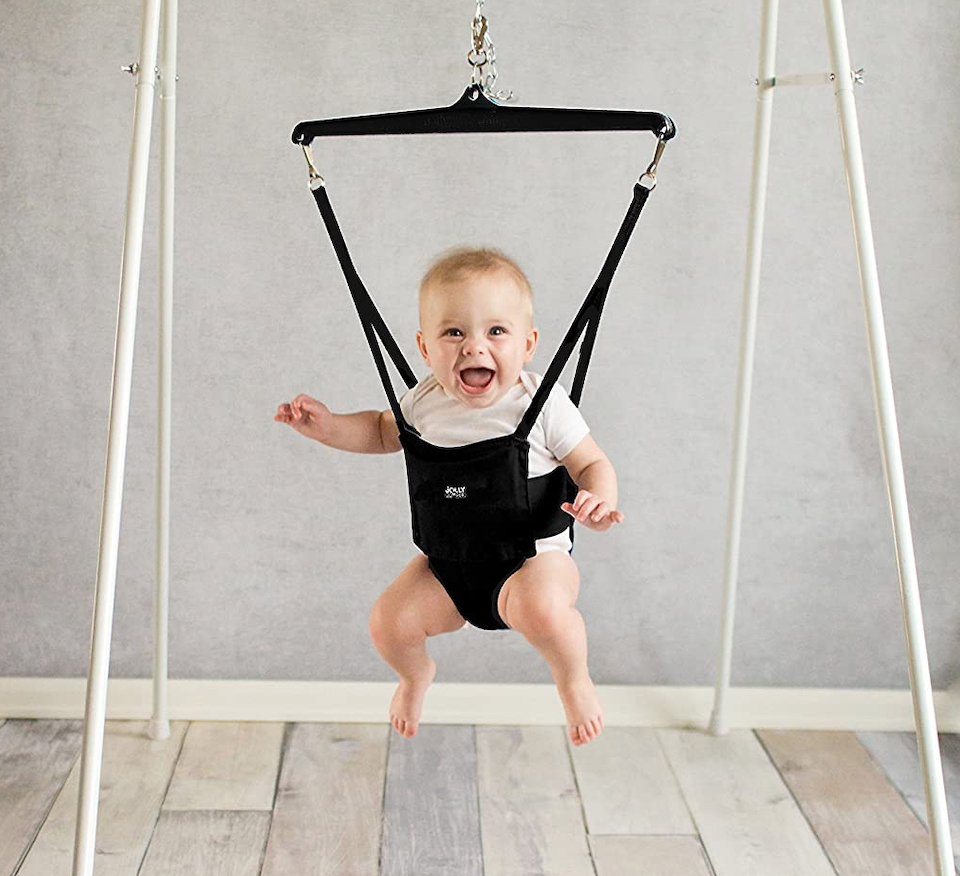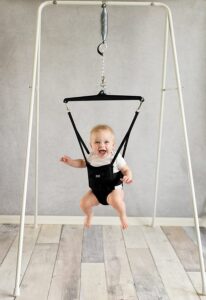blog
Jolly Jumpers: Are They Good Or Bad?
August 29, 2022

If you have ever seen a child on a Jolly Jumper (also known as baby bouncers or jumperoos), you might know the look of delight on their face whilst they bounce away. In recent years, however, Jolly Jumpers have come under scrutiny as to whether they may do more harm than good when it comes to healthy lower limb development and reaching developmental milestones.
This is a question our podiatry team is asked every so often, so we thought we’d share some current research and facts about jolly jumpers to help you make an informed decision about what is best for your child.
Two Sides To Every Story
 Research into the use of jolly jumpers as well as walkers does suggest that if they are used excessively, they could alter the pathway of normal development [1][4][5]. While this outcome is not guaranteed and can vary greatly from person to person, studies that compared infants that did and did not use walkers between the ages of 6 and 15 months showed that walker-experienced infants sat, crawled, and walked later than infants who did not use a walker. Walker-experienced infants also scored lower on mental and motor development scales [4], with one analysis showing the walking delay might be up to 26 days [6].
On the other hand, a recent analysis of the literature found that more studies and clinical trials showed no developmental delays compared to those that showed the presence of delays [7]. When looking at any research, we must be mindful that many other variables and external factors could affect an infant’s development.
With this in mind, there was one strong message: while some studies did find developmental delays from walker and jumper use and others found no delays, we did not come across any studies in favour of walker/jumper use for improving development in infants.
Research into the use of jolly jumpers as well as walkers does suggest that if they are used excessively, they could alter the pathway of normal development [1][4][5]. While this outcome is not guaranteed and can vary greatly from person to person, studies that compared infants that did and did not use walkers between the ages of 6 and 15 months showed that walker-experienced infants sat, crawled, and walked later than infants who did not use a walker. Walker-experienced infants also scored lower on mental and motor development scales [4], with one analysis showing the walking delay might be up to 26 days [6].
On the other hand, a recent analysis of the literature found that more studies and clinical trials showed no developmental delays compared to those that showed the presence of delays [7]. When looking at any research, we must be mindful that many other variables and external factors could affect an infant’s development.
With this in mind, there was one strong message: while some studies did find developmental delays from walker and jumper use and others found no delays, we did not come across any studies in favour of walker/jumper use for improving development in infants.
Your Child’s Natural Development And Musculoskeletal System
Next, we must consider an infant’s natural development pattern and where a walker or jumper may sit within this. In order for an infant to sit up, crawl and eventually walk, they must develop strength, coordination, balance, spatial awareness and more. With this knowledge, it is not surprising that many do argue that the more time a child is supported in these devices, the less time is potentially spent in positions important to developing these core strengths and abilities, such as tummy time [8].
When placed in a jumping or walking device at a young age and without adequate strength, your child may be unable to control their body and movements while bouncing quickly. This means that their movements could be more random and unrelated to strength development, instead of completing movements that assist in developing their control over their leg and trunk position.
The Effect On A Baby’s Hips, Ankles And Legs
Jumpers and walkers tend to support a baby’s weight through their hips, crotch and under their arms. This tends to push your baby forwards, which can affect their posture and control of their trunk and legs.
Combining a forward-leaning posture with standing on their tip-toes, can add stress to the ankle joint, calf muscles and the Achilles tendon. This has been reported to contribute to decreased glute muscle use and the potential shortening of the Achilles tendon when excessive time is spent in this position [8]. This concern is discussed extensively by the Australian Physiotherapy Association, who issued a statement over a decade ago stating that baby walkers should be avoided [9].
It has also been suggested that using jumpers or walkers for prolonged periods could increase an infant’s risk of hip dysplasia due to the hip position these devices require, though there does not seem to be significant evidence to confirm this.
There Is An Injury Risk
Putting musculoskeletal and developmental issues aside, studies do agree and confirm that the rate of preventable injuries from walkers is very high [2][3]. Over 230,000 children aged under 15 months were treated in US emergency departments for walker-related injuries, with over 90% of these injuries being to the head and neck [10]. These findings have led to walker bans in countries like Canada, with sellers risking an instant $100,000 fine.
What’s The Alternative To A Jolly Jumper?
Tummy time. As stated by health guidelines: “Infants (Birth to one year) physical activity particularly through supervised interactive floor-based play in safe environments should be encouraged from birth. For those not yet mobile, 30 minutes of tummy time… spread throughout the day during awake periods is encouraged.” [11]
Tummy time lets your baby continue to develop their core muscles and learn to control their movements. They will feel what it’s like to naturally shift their weight, which is needed to develop the skills required for rolling, crawling, sitting and walking. As each movement is their own, it also helps to build the child’s coordination and motor control.
And If They Love Their Jumper?
As with most research, there are a lot of factors to consider, and one of them must be what you feel is best for you and your baby. If they are developing well, aren’t at risk of hip dysplasia, and their face lights up when they’re in the jumper, you may decide that it’s best to start or continue using a jolly jumper. In these cases, try to limit their use to 10-15 minutes per day, and only after they can sit unaided, so they have already begun to develop their core strength and skills.
If you’re concerned about your child, any pains or niggles, or their developmental milestones, bring them into our podiatry clinic in Remuera, located at the One Health building on Remuera Road. You can book your appointment by calling 09 523 2333 or book online here.
1 – https://onlinelibrary.wiley.com/doi/abs/10.1111/j.1469-8749.1986.tb03929.x
2 – https://www.tandfonline.com/doi/abs/10.1179/146532806X90637
3 – https://pediatrics.aappublications.org/content/100/2/e1.short
4 – https://europepmc.org/article/med/10533994
5 – https://onlinelibrary.wiley.com/doi/abs/10.1046/j.1365-2214.2001.00186.x
6 – https://www.magonlinelibrary.com/doi/abs/10.12968/bjcn.2002.7.11.10889
7 – https://www.ncbi.nlm.nih.gov/pmc/articles/PMC5703622/
8 – https://www.abc.net.au/news/2018-10-22/sa-health-recommends-not-using-baby-walkers-or-jolly-jumpers/10403890
9 – https://australian.physio/DocumentsFolder/Advocacy_Position_Baby_Walkers_2007.pdf
10 – https://pediatrics.aappublications.org/content/142/4/e20174332
11 – http://www.health.gov.au/internet/main/publishing.nsf/Content/health-pubhlth-strateg-phys-act-guidelines#npa05

 Research into the use of jolly jumpers as well as walkers does suggest that if they are used excessively, they could alter the pathway of normal development [1][4][5]. While this outcome is not guaranteed and can vary greatly from person to person, studies that compared infants that did and did not use walkers between the ages of 6 and 15 months showed that walker-experienced infants sat, crawled, and walked later than infants who did not use a walker. Walker-experienced infants also scored lower on mental and motor development scales [4], with one analysis showing the walking delay might be up to 26 days [6].
On the other hand, a recent analysis of the literature found that more studies and clinical trials showed no developmental delays compared to those that showed the presence of delays [7]. When looking at any research, we must be mindful that many other variables and external factors could affect an infant’s development.
With this in mind, there was one strong message: while some studies did find developmental delays from walker and jumper use and others found no delays, we did not come across any studies in favour of walker/jumper use for improving development in infants.
Research into the use of jolly jumpers as well as walkers does suggest that if they are used excessively, they could alter the pathway of normal development [1][4][5]. While this outcome is not guaranteed and can vary greatly from person to person, studies that compared infants that did and did not use walkers between the ages of 6 and 15 months showed that walker-experienced infants sat, crawled, and walked later than infants who did not use a walker. Walker-experienced infants also scored lower on mental and motor development scales [4], with one analysis showing the walking delay might be up to 26 days [6].
On the other hand, a recent analysis of the literature found that more studies and clinical trials showed no developmental delays compared to those that showed the presence of delays [7]. When looking at any research, we must be mindful that many other variables and external factors could affect an infant’s development.
With this in mind, there was one strong message: while some studies did find developmental delays from walker and jumper use and others found no delays, we did not come across any studies in favour of walker/jumper use for improving development in infants.
 Research into the use of jolly jumpers as well as walkers does suggest that if they are used excessively, they could alter the pathway of normal development [1][4][5]. While this outcome is not guaranteed and can vary greatly from person to person, studies that compared infants that did and did not use walkers between the ages of 6 and 15 months showed that walker-experienced infants sat, crawled, and walked later than infants who did not use a walker. Walker-experienced infants also scored lower on mental and motor development scales [4], with one analysis showing the walking delay might be up to 26 days [6].
On the other hand, a recent analysis of the literature found that more studies and clinical trials showed no developmental delays compared to those that showed the presence of delays [7]. When looking at any research, we must be mindful that many other variables and external factors could affect an infant’s development.
With this in mind, there was one strong message: while some studies did find developmental delays from walker and jumper use and others found no delays, we did not come across any studies in favour of walker/jumper use for improving development in infants.
Research into the use of jolly jumpers as well as walkers does suggest that if they are used excessively, they could alter the pathway of normal development [1][4][5]. While this outcome is not guaranteed and can vary greatly from person to person, studies that compared infants that did and did not use walkers between the ages of 6 and 15 months showed that walker-experienced infants sat, crawled, and walked later than infants who did not use a walker. Walker-experienced infants also scored lower on mental and motor development scales [4], with one analysis showing the walking delay might be up to 26 days [6].
On the other hand, a recent analysis of the literature found that more studies and clinical trials showed no developmental delays compared to those that showed the presence of delays [7]. When looking at any research, we must be mindful that many other variables and external factors could affect an infant’s development.
With this in mind, there was one strong message: while some studies did find developmental delays from walker and jumper use and others found no delays, we did not come across any studies in favour of walker/jumper use for improving development in infants.
